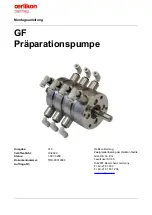
6
The pump is equipped with a stainless steel anti-deposit filter
The temperature of the fluid being pumped must never exceed 35° C.
The pump must not be used to pump salt water (unless specifically designed for the purpose),
sewage, flammable, corrosive or explosive liquids (e.g. petroleum oil, petrol, thinners), grease,
oils or foodstuffs.
Comply with the rules and regulations of the local water authority when using the pump for the
supply of domestic water.
3. STARTING THE PUMP
Given the different provisions applicable to the safety of electric systems in different countries,
make sure that the pump system, as concerns its intended use, is in accordance with current
legislation.
Before starting the pump, make sure that:
• the voltage and frequency specified on the pump’s nameplate coincide with those of the available
power supply;
• there are no signs of damage to the pump or its power cord;
• the electric connection is made in a dry place, protected against any risk of flooding;
• the electric system is complete with a residual current circuit-breaker (I ∆n ≤ 30 mA) and an efficient earthing
connection;
• Any extension cords must comply with the requirements of the DIN VDE standard 0620.
4. RECOMMENDATIONS
To ensure the proper operation of the pump, it is important to comply with the following recommendations:
• The pump must only be used when it is immersed in water.
• The pump must be placed in a stable position inside a trap or in the lowest part of the place where it is installed.
• Periodically, it is advisable to make sure that no dirt (leaves, sand, etc.) has accumulated in the collection trap.
MAINTENANCE AND CLEANING
It is absolutely essential to prevent any risk of the pump freezing. In the event of freezing temperatures, remove
the pump from the liquid, empty it and keep it in a place where it cannot freeze. The pump must be disconnected
from the mains power supply before any cleaning operation is performed. The pump is maintenance free.
ENGLISH
Summary of Contents for 750
Page 4: ......
Page 41: ...37 1 16 15 20 2 30 3 5 24 40 1 NRV...
Page 42: ...38 VNR VNR 50 35 C 3 I n 30 A DIN VDE 0620 4...
Page 44: ...40 6 7...
Page 74: ......
Page 75: ......











































